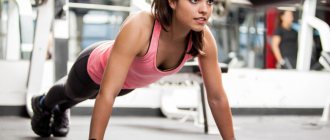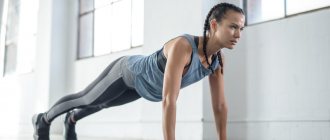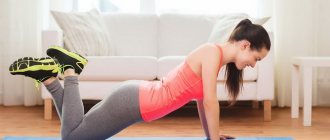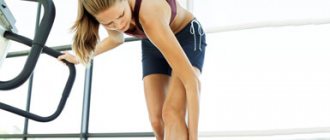A cool, round, toned butt is, perhaps, every girl’s dream. If you decided to take care of your appearance and health, then, of course, you thought about how to pump up your butt. In this article I will talk about how quickly you can pump up your butt at home and what exercises for your butt are the most effective.
Sometimes, women get a large round and toned butt by nature; some women make their butt surgically. But with regular exercise, diligence and determination, you can achieve good results.
How long does it take to pump up your butt?
You will see the first noticeable results and changes in your shape after about one month of regular exercise. During this time, the body will have time to adjust to the “figure correction mode.” In a month you will lose weight and tone your muscles. But only if you exercise regularly, get enough sleep and eat right.
For the first month, you just need to do a set of exercises lasting 40-50 minutes, consisting of 4-5 exercises. I recommend, in addition to the butt, to pump other muscle groups. Kill two, three and even four birds with one stone in one training session. I’m sure that in addition to a beautiful butt, you wouldn’t mind having a beautiful toned stomach and toned chest, so, in addition to exercises for your butt, you can pump up your abs and do exercises for your chest and back every workout.
You need to exercise 2-3 times a week. After each workout, there should be at least one full day of rest.
Exercises for home - workouts in 20 seconds
First, you need to learn how to do static stretching. In this complex, it is important to hold a certain position in each exercise (20 seconds). Watch your breathing, it should be even and deep, you should not hold it if this is not intended for the exercise.
When performing even the simplest complex, pay attention to the spine, it should be straight. To study this or that complex, look for a video on the Internet, an experienced trainer will explain to you all the necessary nuances.
What exercises can you do to pump up your butt at home in 1 month?
Next, I will tell you which, in my opinion, exercises for the buttocks and thighs are the most effective.
By the way, there is one interesting fact. To make your butt visually higher, you also need to train your lower legs (calves and soleus muscles). Try standing on your toes and you will feel your buttocks tightening and lifting. Therefore, we definitely include an exercise for calves in our training program.
The exercises below can be used as a complex and initial training program to pump up your butt at home. Do them 2-3 times a week. The total duration of the workout should be 40-50 minutes. Rest between sets – 1 minute, between exercises 3 minutes.
In a month, you will see that your butt has become much more toned and beautiful.
Squats
Squats are an effective exercise to quickly pump up your butt at home.
The most effective exercise for the legs, and, of course, for the butt, is squats. A beautiful butt is impossible without beautiful, slender and toned legs. And squats are a complex exercise that trains almost the entire body: legs, buttocks and back.
I recommend squatting with a stick (or mop:) on your shoulders. This technique is used for barbell squats. If in the future you decide to squat not at home, but in the gym, then it will be easier for you to squat with a barbell, since you will master this technique.
A few important rules when doing squats so as not to harm yourself.
- The back should be straight and not bend. Otherwise, you can get an intervertebral hernia.
- The knees should not protrude beyond the toes. Otherwise, you may get a knee injury. Push your butt back as far as possible.
- Don't squat deeply. The thighs should be parallel to the floor, and the butt should not fall below the knees. Squats that are too deep can put dangerous stress on your knees.
If squats at home are too easy for you, you can buy dumbbells and squat with dumbbells. No dumbbells? Take bottles of water, or wear a backpack with books - also an option.
Lunges
How to do lunges to pump up your butt
Lunges are a great exercise for enlarging your hips and buttocks. Lunges are a good way to work your legs and buttocks, making them more elastic, toned and sculpted. There are many variations of lunges, but my favorites are straight lunges in place and walking lunges. The difference between them is that when you lunge on the spot, you step back, and when you lunge up, you return to the starting position. When walking with lunges, on the contrary, you step forward, and when you rise, it turns out that you move one step forward.
Tips on how to do lunges correctly.
- Keep your back straight.
- The knee, as with squats, should not protrude beyond the toe. The thigh should be parallel to the floor.
- Lift your body using the muscles of the buttock of your front leg.
- Inhale as you lower, exhale as you rise.
You can do this exercise with or without dumbbells, depending on your fitness level.
You can start with 3 sets of 10-12 repetitions on each leg. Over time, you will feel the load, and you will be able to adjust the number of approaches and repetitions that are optimal for you.
Swing your legs back
Swing your legs back - an exercise for the buttocks to quickly pump up your butt
If squats and lunges are complex exercises for the legs and butt, then swinging your legs back is a very cool exercise specifically for the buttocks. It also tightens the thighs. There are several variations of swings, but the most effective is swinging your legs from a standing position on your knees and hands or elbows, whichever is more convenient for you (dog pose, on all fours).
How to do swings? Get into the starting position on all fours. Slowly move your leg back. The back should be straight. The leg can be pulled back in a straight position, or bent at a right angle. I recommend combining the straight and bent leg option.
If your buttocks “burn”, it means you’re doing everything right. Do it through “I don’t want”, through “I can’t” and despite the burning sensation.
Do about 3 sets of 20 reps with each leg. In the last approach, you can do the maximum number of repetitions.
If the exercise is too easy for you, buy leg weights.
Lifting the pelvis while lying on your back
The pelvic lift while lying on your back is one of the best exercises for the buttocks to quickly pump up your butt.
The pelvic lift while lying on your back is perhaps the best exercise for the buttocks.
How to do a pelvic lift while lying on your back? Lie on your back, stretch your arms along your body, bend your legs at the knees and place your feet on the floor. As you exhale, slowly lift your buttocks. At the highest point, freeze for a moment, then slowly lower your pelvis. Try to feel how your butt tenses. Do not lower yourself completely, your butt should not touch the floor - you need to maintain tension throughout the entire exercise.
To begin with, I also recommend doing 3 sets of 15-20 repetitions.
If the exercise seems too easy for you, you can use additional weights. Place something heavy on your lower stomach, holding it slightly with your hands. It could be a thick book, a water bottle or something else.
Causes of overtraining
Overtraining is a tricky thing. It can “cover” any person: be it a professional bodybuilder with many years of experience working with iron or a beginner who has only a month of sports experience. For Her Highness, it does not matter at all what length of training and experience in the gym, what is important is what actions led to the state of overtraining.
And these actions could be as follows:
The phenomenon of sports addiction
This reason is most common among beginners, but it also happens among “experienced” athletes. The fact is that during training and immediately after it, endorphins (joy hormones) are released into the blood; they make a person feel happy and satisfied. Surely you have noticed that after a quality workout you feel inspired and ready to do great things? These are the consequences of the work of endorphins. So, this is the state when you want to move mountains and prove to yourself that you are still capable of something other than that, and exposes you to the danger of falling into the trap called “overtraining.”
Under the influence of this euphoria, you begin to attend the gym/group classes (not so important) every day and squeeze all the juice out of yourself! When you do this, you feel GOOD, you enjoy the training process itself, and you feel like the happiest person. But this emotional upsurge can quickly give way to apathy if you don’t stop in time and give the body the necessary rest.
Among professional athletes, sports addiction manifests itself in the desire to achieve greater results by increasing the intensity of their training, reducing the rest time between approaches, increasing weights and the frequency of the exercises themselves (more than once a day), etc. Here you need to understand: “More does not mean better.” Frequent training “to the point of exhaustion” and to the point of complete failure can lead you to the completely opposite result. Instead of the progress you are looking forward to, in the form of muscle growth, increased endurance, increased athletic performance, etc., you get exactly the opposite: the destruction of your muscles, decreased endurance, decreased performance and decreased athletic performance.
Following the same program for a long time
This reason can also cause overtraining, when the body receives the same load day after day (consistency of working weights, number of repetitions and approaches) on the same muscle groups. Consistency and stability are, of course, good, but not in such a fanatical mode. Your training program on average should change every month or two, in extreme cases – once every 3 months, but not less often! If you monotonously follow the same program for quite a long time, this will lead you to “emotional burnout,” when you simply feel sick of the very word “workout,” and to physical fatigue, which will affect decreased performance and muscle fatigue . We will talk about these and other symptoms of overtraining
Insufficient rest and sleep
Sleep and rest are one of the most important factors on which your well-being and overall health depend. Even if you don’t play sports, but simply lead an active lifestyle: you work 8-10 hours a day, do household chores, raise children, take English courses, etc., then you MUST get at least 8 hours of sleep in a day. And if, in addition to all this, you also play sports, regularly visiting a fitness club, and do not allow yourself to miss at least one lesson, then you EVEN MORE need to pay great attention to sleep and rest. The process of restoring muscle tissue after training takes on average from 24 hours to several days, and if the training was too intense, then complete recovery can take up to one month. That is why you should not neglect the rest phase in order not to put your body into a state of overtraining.
Poor nutrition and deficiency of nutrients
Another common reason for overtraining is too low a calorie diet and a deficiency of micro- and macroelements. When the body receives substances that are insufficient for its normal functioning, catabolic processes (destruction) begin to predominate over anabolic processes (synthesis). In this situation, muscle tissue begins to actively break down, which, along with intense training, drives the body into a state of “eating itself.” But the worst thing here is not that your biceps or butt will “deflate” (it’s not a problem to build them back), what should scare you most is that your heart and other vital organs may suffer , since they are all composed from the same muscle tissue that makes up your biceps, triceps, quads and glutes. That is why a deficiency of nutrients (vitamins and minerals), as well as an insufficient amount of proteins, fats and carbohydrates can play a cruel joke on you and one fine training day “put” you to rest for a couple of weeks (or even months) in order to you had time to think about your mistakes.
Stress at work and at home. Decreased immunity
Constant stress, as well as painful conditions, play a big role in overtraining the body. The mechanism is very simple: during stress and during periods of decreased immunity/illness, the stress hormone cortisol increases in the blood; it is responsible for the catabolic processes that occur in the body. You already know about these processes from the previous paragraph. It turns out that:
a) having unresolved problems at work or at home, you are constantly in a state of catabolism (muscle destruction), which means you are at an increased risk of overtraining.
b) being in a state where you have a weakened immune system or you know 100% that you are sick, you are also at increased risk of driving your body into a state of overtraining.
- Sports and colds. Is it possible to exercise when you have a cold?
WHAT TO DO?
During these periods, it is better to reduce the intensity of your training or even take a short break (2-3 weeks) and allow the body to recover from the stressful state without serious consequences for health. Two weeks won't make much difference to you, but you will save yourself from the serious consequences of overtraining.
And before moving on to considering the signs of overtraining, I cannot help but say about the types of this phenomenon themselves.
Calf raise
Standing calf raises help make your legs slimmer and your butt more toned.
Calf raises are a fairly simple exercise. It does not pump up the butt muscles, but is aimed at your lower legs - the calf and soleus muscles. But, as I wrote above, beautiful calves indirectly affect the butt. They lift it up visually. Another advantage of carved and sculpted shins is that they visually make the knees narrower and the legs look slimmer.
There are two main ways to do this exercise: standing and sitting. But they are fundamentally different. While standing, you train the calf muscle, while sitting, the soleus muscle, which is located under the gastrocnemius. Both muscles make your calves look bigger. Therefore, you need to do both versions of this exercise, both standing and sitting.
How to do calf raises while standing? You need to find some kind of stand or threshold. Stand with your toes on the stand so that your heels hang down. It is advisable to stand near a wall or chair so that you can hold on with your hands. Slowly rise onto your toes, then pause for a moment and lower yourself.
Seated calf raise. Working out the shins tightens the butt and makes it taller.
You can use additional weights to increase the load. This could be dumbbells, water bottles or a backpack.
How to do calf raises while sitting? The sitting calf raise technique is similar to the standing calf raise technique. But when lifting while sitting, be sure to use additional weights: dumbbells or water bottles. Sit on a chair, put your socks on a stand, place dumbbells on your knees, holding them with your hands. Slowly raise and lower your knees, pausing momentarily in the highest and lowest positions. Lower your heels as low as possible, stretching your calves. Inhale as you rise, exhale as you lower.
Note: it is not necessary to use a stand; you can push off with your toes from the floor, but with a stand the exercise will be more effective.










